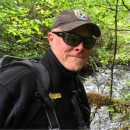Tryon Creek is a relatively undisturbed urban watershed located in southwest Portland, Oregon. The habitat is well suited for native fish; however, the lower portion of the stream is bisected by a culvert that runs under Oregon State Highway 43. To improve habitat and passage conditions for anadromous fish, a collaborative project retrofitted the culvert with a new baffle system, elevated the pool below the culvert, and enhanced floodplain habitat. From 2005-2019, the U.S. Fish and Wildlife Service worked with the City of Portland to assess the response of multiple species historically present, or believed to be present, in Tryon Creek. Goals were to evaluate fish 1) community, 2) relative abundance, and 3) residence time downstream of the Highway 43 culvert (confluence habitat), 4) estimate the population abundance of trout species upstream of the Highway 43 culvert and 5) investigate larval lamprey occupancy throughout the creek. Between 2012 and 2019, we handled a total 7,425 individual fish among 22 species in the confluence habitat. Native fish were the most abundant comprising 64% (n = 14) of the species captured and 99% (n = 7,351) of the individuals captured. The majority of juvenile anadromous salmonids (Chinook and Coho Salmon) captured in the confluence habitat were of wild origin from elsewhere in the Willamette River Basin (2,170/2,234), all other juvenile anadromous salmonids were hatchery-reared (likely from upstream Willamette River hatcheries). Juvenile Chinook and Coho Salmon were present in the confluence habitat throughout the year and the numbers captured peaked in the winter and spring months. Juvenile anadromous salmonids were detected emigrating from Tryon Creek a median 18 days after their initial capture in the confluence habitat. Salmonids exhibiting both resident and anadromous behaviors (Coastal Cutthroat Trout and hybrid trout) were detected emigrating from Tryon Creek a median 58 days after tagging in the confluence habitat. In 2019, the estimated abundance of trout in 1) Tryon Creek between the Highway 43 and the Boones Ferry Road culverts was 556 (95% CI [474, 660]) individuals, 2) 103 (95% CI [85, 130]) individuals upstream of the Boones Ferry Road culvert and below the SW Maplecrest Drive culvert in Tryon Creek as well as below SW Arnold Street in Arnold Creek, and 3) 63 (95% CI [45, 104]) individuals in Nettle Creek. Since 2005, multiple species of lamprey (primarily larval Pacific Lamprey) have been found in Tryon Creek downstream of the Highway 43 culvert but not upstream of the culvert.
Publication date
Type of document
Annual Report
Facility
Program
Species
FWS Focus
Ecosystem
FWS and DOI Region(s)





